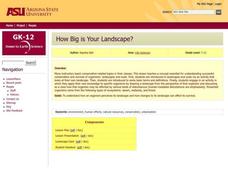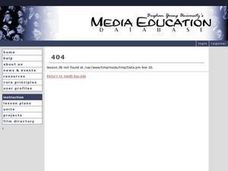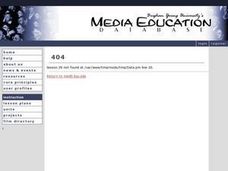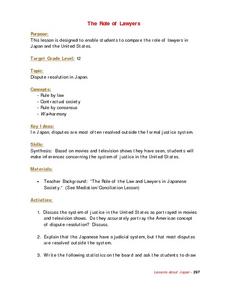Curated OER
The Role of International Organizations in Peacekeeping
Eighth graders are given two case studies. They determine if the United Nations should become involved, and if so, in what capacity? students explain their decisions based on a set of criteria determined by the class.
Curated OER
How Big Is Your Landscape?
Students explore how an organism perceives its landscape and how changes to its landscape can effect its survival. Of particular focus is the effect of urbanization and the organisms survival in the cities.
Curated OER
Suffering in Sudan
Students investigate the humanitarian crisis in the Sudan. They examine the make up of the rebel groups involved in the fighting and the attempts to resolve the conflict.
Curated OER
Cultural Representation in "Spellbound" Part 1
Students watch the film "Spellbound". They analyze concepts of how the media represents race. They discuss how the movie depicts race after the film.
Curated OER
Culture Representation in "Spellbound" Part 2
Students watch the film "Spellbound". They examine how the film represents race. They analzye contemporary media to examine how they represent race as well.
Curated OER
The Role of Lawyers
Twelfth graders compare and contrast the role of lawyers in Japan and the United States. After viewing movies and television shows, they make guesses about the justice system in the United States. They answer discussion questions and...
Curated OER
The Concept of Wa II
Twelfth graders are introduced to the concept of wa in the Japanese culture. In groups, they compare and contrast the way disputes are handled in both countries. They are given a case in which they state the facts and the issues involved.
Curated OER
Tools of the Archeologist
Young scholars review the job of an archeologist as a class. While viewing a PowerPoint presentation, they guess the use of the tool before the next slide is shown. They also discuss when the archeologist would use each of the twelve...
Curated OER
Point of View
Students participate in an inkblot test to discuss how what they see is different than their classmates. After viewing various artifacts, they write down what they believe the object is and then they are placed into a group to discuss...
Curated OER
Decomposing Artifacts
Seventh graders participate in an experiment in which they calculate the time of decomposition of different materials. In groups, they fill bags with different materials and cover them in soil. After six months, they create a line graph...
Curated OER
Mapping an Artifact
Young scholars copy a present day artifact onto graph paper. In groups, they decide the scale of the drawing and create the picture using specific graphing points. They are also given photographs in which there are no graphing points and...
Curated OER
Gridding a 2 x 2 Meter Unit
Learners use the internet to examine what happens at an archeological dig site. In groups, they practice measuring a 2x2 meter square unit and gridding it out as an archeologist would do. They review the possible solutions at the end of...
Curated OER
Gridding a Site
Learners make observations of effigy mounds and record them in a notebook. In groups, they must determine the scale of measurement and create their own grid to scale part of the Effigy Mounds National Monument. They also practice using...
Curated OER
2 x 2
Students work together to grid a 2 x 2 meter unit using the formula for the Pythagorean Theorem. After creating the grid, they identify the location of artifacts and create a map of their location. They develop a graph and table of their...
Curated OER
Does This Belong to You?
Fourth graders examine legislation that has been passed to protect the rights and religion of Native Americans. In groups, they discuss their feelings on others taking artifacts from Native American sites and what they do if they find...
Curated OER
Archeological Thinking
Sixth graders review the differences between a historian and archaeolgists. At a recent archaeological dig site, they examine the artifacts and determine their usage. In groups, they are given a bag full of artifacts and write down what...
Curated OER
How Do We Learn About the Past?
Sixth graders discuss the role of an archaeologist as a class. After viewing photographs, they relate the objects found in their local area and Ancient Egypt. They draw a picture of an object that represents their own culture and gives...
Curated OER
Pieces of an Artifact
Students review what an artifact is and discover what happens when only pieces of the artifact are found. In groups, they are given a picture of a small piece of an artifact found and they are to make the entire drawing of the artifact...
Curated OER
What a Site!
Fourth graders are introduced to how to properly create a grid site. In groups, they use Cartesian coordinates to establish the boundaries for the grid and photograph the location of artifacts. They exchange their photos with another...
Curated OER
People of the Past
Young scholars investigate the four groups of people that existed in the U.S. before the European settlers arrived. They predict how the people arrived in the U.S., then investigate their predictions to find out whether or not they are...
Curated OER
Culture Challenge
Students identify and classify characteristics of the four pre-European cultures in Wisconsin. They playing a game about the different characteristics that belong to each of the cultures studied.
Curated OER
Rock Art
Students create replica symbols of rock are found in Wisconsin and work cooperatively to create a rock art panel. They observe rock art to find their meanings and reasons why they were created.
Curated OER
People/Culture
Seventh graders explain both past and present examples of how people use of natural resources. They use the MVAC website to garther information about the prehistoric cultures in Wisconsin.
Curated OER
Memory/Physiology Lab Activity
Learners investigate the nervous system and how physical distractions influence mental performance. They work in pairs as a researcher and subject and memorize a series of words with no distractions. After repeating the list of words,...
Other popular searches
- Peer Mediation
- Peer Mediation Scenarios
- Mediation Scenarios
- Teaching Peer Mediation
- Peer Mediation Activities
- Conflict Mediation
- Mediation Skills
- Peer Mediation Role Plays
- Mediation Process
- Peer Counseling: Mediation
- Mediation and Arbitration
- Mediation Lesson Plans

























